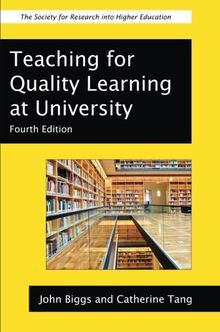
Foreword to the first edition:"This book is an exceptional introduction to some difficult ideas. It is full of downright good advice for every academic who wants to do something practical to improve his or hers students' learning."
Paul Ramsden, Brisbane, Australia
Endorsements for the fourth edition:
"Biggs and Tang present a unified view of university teaching that is both grounded in research and theory and replete with guidance for novice and expert instructors. The book will inspire, challenge, unsettle, and in places annoy and even infuriate its readers, but it will succeed in helping them think about how high quality teaching can contribute to high quality learning."
John Kirby, Queens University, Ontario, Canada
"For those teaching in schools and universities this book provides a framework that can be used to guide teaching from thinking about what a program, topic, lesson or lecture should be about, to the execution of the teaching and reflection on the outcomes. The guiding framework emerges from a sound conceptual analysis of the how the interaction between teacher and student can be organised to result in learning that enables students to approach the levels of understanding and problem solving that we hope will emerge from our teaching."
Mike Lawson, School of Education, Flinders University, Adelaide, Australia
This best-selling book explains the concept of constructive alignment used in implementing outcomes-based education. Constructive alignment identifies the desired learning outcomes and helps teachers design the teaching and learning activities that will help students to achieve those outcomes, and to assess how well those outcomes have been achieved. Each chapter includes tasks that offer a 'how-to' manual to implement constructive alignment in your own teaching practices.
This new edition draws on the authors' experience of consulting on the implementation of constructive alignment in Australia, Hong Kong, Ireland and Malaysia including a wider range of disciplines and teaching contexts. There is also a new section on the evaluation of constructive alignment, which is now used worldwide as a framework for good teaching and assessment, as it has been shown to: